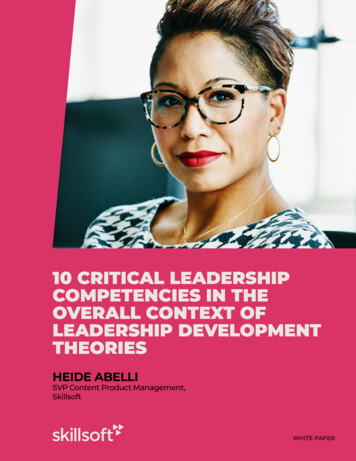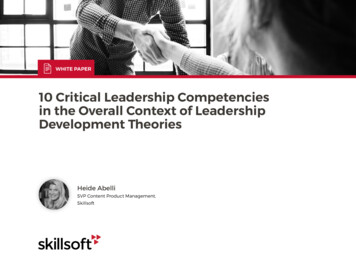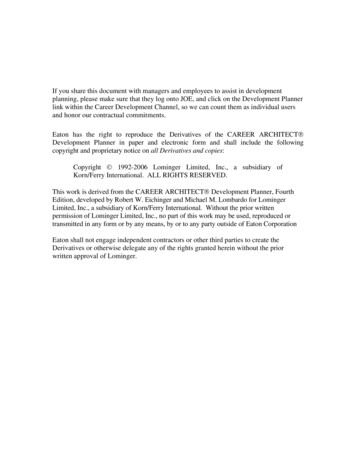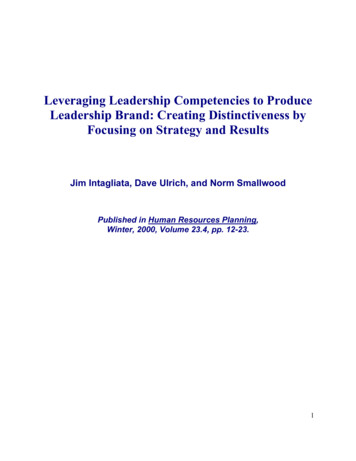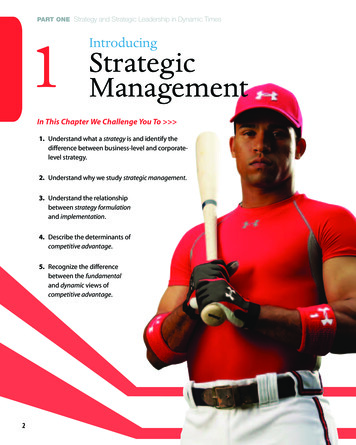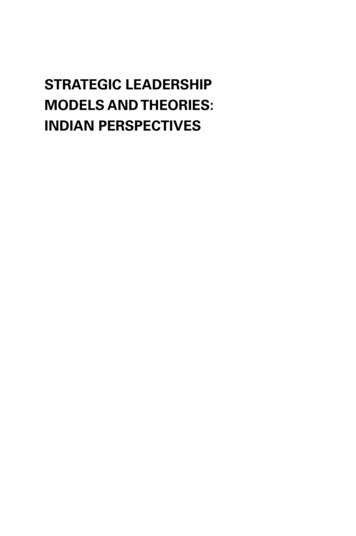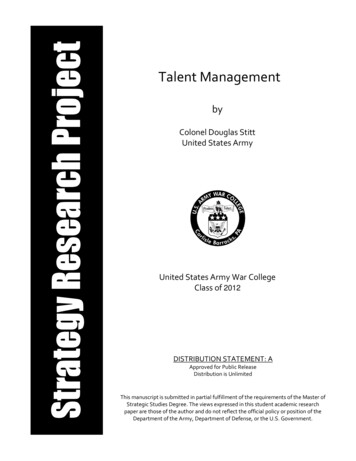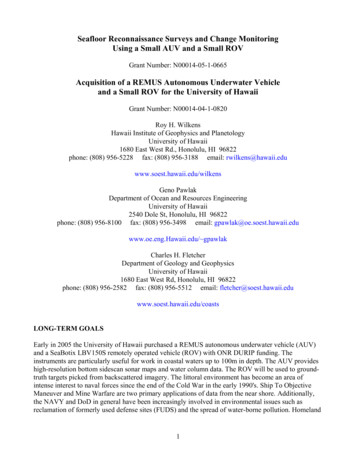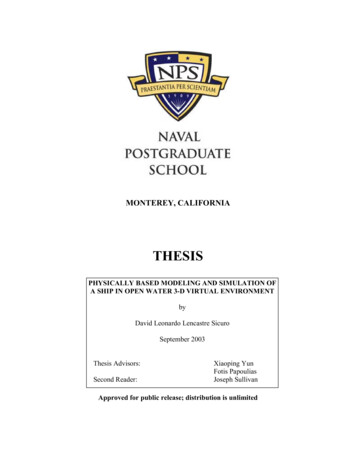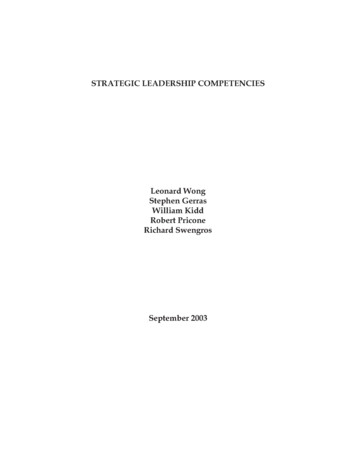
Transcription
STRATEGIC LEADERSHIP COMPETENCIESLeonard WongStephen GerrasWilliam KiddRobert PriconeRichard SwengrosSeptember 2003
Form ApprovedOMB No. 0704-0188Report Documentation PagePublic reporting burden for the collection of information is estimated to average 1 hour per response, including the time for reviewing instructions, searching existing data sources, gathering andmaintaining the data needed, and completing and reviewing the collection of information. Send comments regarding this burden estimate or any other aspect of this collection of information,including suggestions for reducing this burden, to Washington Headquarters Services, Directorate for Information Operations and Reports, 1215 Jefferson Davis Highway, Suite 1204, ArlingtonVA 22202-4302. Respondents should be aware that notwithstanding any other provision of law, no person shall be subject to a penalty for failing to comply with a collection of information if itdoes not display a currently valid OMB control number.1. REPORT DATE3. DATES COVERED2. REPORT TYPESEP 200300-00-2003 to 00-00-20034. TITLE AND SUBTITLE5a. CONTRACT NUMBERStrategic Leadership Competencies5b. GRANT NUMBER5c. PROGRAM ELEMENT NUMBER6. AUTHOR(S)5d. PROJECT NUMBER5e. TASK NUMBER5f. WORK UNIT NUMBER7. PERFORMING ORGANIZATION NAME(S) AND ADDRESS(ES)U.S. Army War College,Strategic Studies Institute,122 ForbesAve,Carlisle,PA,170139. SPONSORING/MONITORING AGENCY NAME(S) AND ADDRESS(ES)8. PERFORMING ORGANIZATIONREPORT NUMBER10. SPONSOR/MONITOR’S ACRONYM(S)11. SPONSOR/MONITOR’S REPORTNUMBER(S)12. DISTRIBUTION/AVAILABILITY STATEMENTApproved for public release; distribution unlimited13. SUPPLEMENTARY NOTES14. ABSTRACT15. SUBJECT TERMS16. SECURITY CLASSIFICATION OF:a. REPORTb. ABSTRACTc. THIS PAGEunclassifiedunclassifiedunclassified17. LIMITATION OFABSTRACT18. NUMBEROF PAGESSame asReport (SAR)1819a. NAME OFRESPONSIBLE PERSONStandard Form 298 (Rev. 8-98)Prescribed by ANSI Std Z39-18
*****The views expressed in this report are those of the authors and do not necessarily reflect the officialpolicy or position of the Department of the Army, the Department of Defense, or the U.S. Government.This report is cleared for public release; distribution is unlimited.*****ii
FOREWORDOn December 21, 2001, the Chief of Staff of the Army tasked the U.S. Army War College toidentify the strategic leader skill sets for officers required in the post-September 11th environment.The following report is the result of that tasking. Dr. Leonard Wong, assisted by four U.S. Army WarCollege students, reviewed the strategic leadership literature, interviewed corporate leader developers,analyzed the leader development system, and gathered the views of key leader developers in theArmy. They distill the essence of strategic leadership into six metacompetencies that not only describestrategic leadership, but also provide aiming points for an integrated leader development system.DOUGLAS C. LOVELACE, JR.DirectorStrategic Studies Instituteiii
SUMMARYThe strategic leadership literature in both the academic and military contexts is replete with longlists of the knowledge, skills, and abilities needed by strategic leaders of the future. Unfortunately, longcomprehensive lists are problematic. At the individual level, it is difficult to assess one’s leadershipability when the lists suggest that a strategic leader must “Be, Know, and Do” just about everything.At the institutional level, the long lists make it difficult to focus an institution’s attention and resourceson leader development when the desired endstate is so broad. Hence, the task of identifying thecompetencies of future strategic leaders becomes one of reducing the lists to a few metacompetenciesthat will prove useful in: a) directing leader development efforts in the process of producing leaderswith strategic leader capability, and b) facilitating self-assessment by officers of their strategic leadercapability. Looking across the existing literature on strategic leadership, the current lists of Armystrategic leader competencies, and the future environment of the Objective Force, six metacompetenciescan be derived: identity, mental agility, cross-cultural savvy, interpersonal maturity, world-class warriorwarrior,and professional astuteness. These metacompetencies describe the strategic leadership necessary for thefuture Army.v
STRATEGIC LEADERSHIP COMPETENCIESOn December 21, 2001, the Chief of Staff of theArmy (CSA) tasked the U.S. Army War College(USAWC) to identify the strategic leader skill setsfor officers required in the post-September 11thenvironment. In his charter guidance, the CSAspecifically stated:of the “strategic Captain” or “strategic Corporal”guarding the Brcko Bridge. This use of “strategic”broadens the definition to such a degree that allsoldiers should be strategic. On the other hand,“strategic” is often used in the narrow sense withthe view that the Army’s strategic leadershipresides solely in the general officer ranks. Aneven more narrow interpretation views strategicleaders only at the 3-star level and above.This report assumes that future strategic leadercapability will be required at the Brigade-levelcommander (i.e., the Stryker Brigade CombatTeam level) or the O-6 level staff officer who willhave increased strategic responsibilities. Thisdistinction is important for several reasons. First,stating that strategic leader capability, but notnecessarily strategic leadership, is required at theO-6 level recognizes that senior officers will needto think strategically, even if they are not in troopleading positions. For this study, “strategic”refers to a way of thinking—not just a level of warbeyond tactical and operational. Strategic leadercapability is required in those officers who haveincreased responsibility for an organization, whoare concerned with internal as well as externalspheres of influence, and who are surroundedby ambiguity and complexity.1 Second, shiftingstrategic leader capability down to the colonellevel greatly expands the target population ofany leader development efforts. Strategic leaderdevelopment must become more deliberate ifthe number of officers requiring strategic leadercapabilities increases from 300 general officers toseveral thousand colonels.The use of the phrase “strategic leadercapability” has significant implications.Itrecognizes that although not all colonels orgeneral officers are in strategic leader positions,they still can (and should) possess a level ofstrategic leader capability.Strategic leadercapability also implies a potential that is notinstantly acquired, but needs to be developed andmatured over time.This report also assumes that the comprehensive Army Training and Leader DevelopmentThe first of the critical areas to be examinedis the identification of strategic leader skillsets for officers in the post-September 11thenvironment, and those necessary to meet theleadership requirements of the Objective Force.In conducting the study, the student studyteam must start with the Army Training andLeader Development (ATLD) Panel (Officer)recommendations as a baseline, and build on thegreat work already done in this arena. In additionto strategic skill sets, the required knowledge andattributes of the future Objective Force leadershould also be discussed.A research group of four students and afaculty advisor completed the following reportafter extensive research and analysis. Researchvisits conducted by the team included the Centerfor Army Leadership, the Objective Force TaskForce Office, the Army Research Institute for theBehavioral and Social Sciences, U.S. Army CadetCommand, the U.S. Military Academy, Trainingand Doctrine Command headquarters andschools, and the leader development offices in theOffices of the Deputy Chief of Staff for Personnel(DCSPER) and Operations and Plans (DCSOPS).Additionally, the group consulted with leaderdevelopment experts in organizations such asthe Center for Creative Leadership, Bristol-MyersSquibb, and Strategic Leadership Solutions.Assumptions.The CSA charter began by stating the need toidentify the skill sets required of future strategicleaders.Before identifying these skill sets,however, it is useful to define what a strategicleader of the future actually means. Ironically,“strategic” is often used at both ends of thehierarchical spectrum. It is not uncommon to hear1
(ATLD) Panel (Officer) report adequately coveredthe development of direct and organizationallevels of leadership. Thus, there is no reasonto examine the development of leadershipcompetencies other than strategic leadershipcompetencies. This report also assumes that theleadership competencies required at the directand organizational levels will be resident inemerging strategic leaders.Finally, this report assumes that a postSeptember 11th environment is the same as theObjective Force environment. Both environmentsinvolve breaking the linear method of warfareand allowing the Nation to directly applyoperational maneuver from strategic distancesthrough the use of joint and coalition forces. Bothperspectives require strategic leaders capable ofhandling a more complex, uncertain, and globalsecurity environment.2vision with the mission and environment througha strategic plan. Aligning consists of ensuring theorganizational structure, systems, and operationalprocesses all contribute to achieving the missionand vision. Empowering is igniting the latenttalent, ingenuity, and creativity in the people toaccomplish the mission.Other leadership theorists bring up aspectsof strategic leadership not included in Covey’stypology. In his research on future strategicleadership, James F. Bolt focuses less on theenvironment and more on the leader.5 He arguesthat there are three dimensions of a leader:business, leadership, and personal effectiveness.The business dimension has been traditionallythe focus in executive development. This dimension includes the creation of new kinds oforganizations, leading change, and how theorganization works. The leadership dimensionhas typically been overlooked because manypeople do not believe it can be taught. Accordingto Bolt, this dimension is developed by the studyof a broad range of classical and contemporaryleadership theories and skills. The personaleffectiveness dimension, according to Bolt, has beenneglected because of the widespread view thatwork and personal matters must be separated.The personal dimension concentrates on helpingto clarify and develop an individual’s purpose,vision, values, and talents. The emphasis onself-reflection is found in the “self-leadership”literature that is becoming popular and is actuallyas old as Thales (“Know thyself”) or Shakespeare(“To thine own self be true.”).A related aspect emerging in the strategicleadership literature is self-efficacy.6 Self-efficacyrefers to individuals’ judgments about theirperceived capabilities for performing specifictasks. Self-efficacy is the result of life experiencesthat teach one that one can, in fact, take actionsthat will effectively have an impact on one’senvironment. This concept parallels the findingsof the Army Training and Leader Development(ATLD) Panel. In the ATLD report, one of thetwo leadership competencies for the 21st centuryis self-awareness. Self-awareness is the abilityto assess abilities, determine strengths in theStrategic Leadership.The search for strategic leader competencies3is a natural progression of the research in the fieldof leadership. In the late 1980s, some social scienceresearchers began to question whether leadershipactually made a difference in organizationswhile others suggested that perhaps the studyof leadership had reached its culminating point.Rather than disappearing, however, the study ofleadership took on new energy with an emphasison leadership of organizations, rather than thetraditional leadership approaches that focused onface-to-face interaction at lower levels. Studiesof transformational leadership, organizationalculture, visionary leadership, organizationalchange, and charismatic leaders reinvigorated thefield of leadership. Thus, the notion of strategicleadership was introduced.While lists of leadership competencies werevery popular in the 1980s, the most recentliterature distills strategic leadership to a fewkey skills and competencies or a process. Forexample, Stephen Covey states that strategicleaders have three basic functions: pathfinding,aligning, and empowering.4 Pathfinding dealswith tying the organization’s value system and2
environment, and learn how to sustain strengthsand correct weaknesses. The ATLD report alsoargues that a key leader competency is adaptability.According to the panel, adaptability is the abilityto recognize changes to the environment, todetermine what is new, what must be learnedto be effective, and includes the learning processthat follows that determination.7Karl Weick states that in a world ofuncertainty and doubt, leaders must focus oncertain properties. Two of those properties areimprovisation and lightness.8Improvisationinvolves the flexible treatment of preplannedmaterial. It is not about making somethingout of nothing. Instead, it is about makingsomething out of previous experience, practice,and knowledge. Improvisation is something thatis almost intuitive to good leaders at the tacticallevel, but seldom is addressed at the strategiclevel.Weick’s novel concept of lightness refers tothe ability to drop heavy tools that are no longeruseful. Weick’s analogy is the foreman who yells,“drop your tools,” to wildland firefighters whoare trying to outrun an exploding fire. Firefighterswho refuse to drop heavy tools such as chainsawsare prone to be overtaken by the fire and perish(as has happened at least 23 times since 1990).To strategic leaders, the now-unwieldy tools arethose that presume the world is stable, knowable,and predictable. Future strategic leaders must beable to drop outmoded perspectives, methods, orassumptions in a world of uncertainty.In their review of strategic leadership, KimBoal and Robert Hooijberg distill the essence ofstrategic leadership to three factors—effectivestrategic leaders must create and maintainabsorptive and adaptive capacity in additionto obtaining managerial wisdom.9 Absorptivecapacity involves the ability to learn byrecognizing new information, assimilating it,and applying it. Adaptive capacity involves theability to change due to variations in conditions.Managerial wisdom consists of discernment andintuition. Boal and Hooijberg’s assertion thatabsorptive and adaptive capacities are requiredat the strategic level of leadership is very similarto the Army’s emphasis on self-awareness andadaptability. Although the Army competenciesare intended to apply to all levels of leadership,not just strategic leaders, it is interesting to seethe parallel development of parsimonious leadercapabilities in both the military and academicliterature.Strategic Leadership in the Military.In 1991, the U.S. Army War College hosteda conference on the fledgling field of strategicleadership. At that conference, strategic leadershipaspects were based on Jaques’s Stratified SystemsTheory (SST).10 SST essentially argues that thereare critical tasks that must be performed byleaders in effective organizations. At each higherlevel in an organization, these tasks becomeincreasingly complex and qualitatively different.Consequently, leaders at the strategic levels musthave higher levels of cognitive complexity—theability to deal with abstract, longer timeframeconcepts. The influence of SST on the ArmyWar College (and the broader Army) is evidentwith the emphasis on cognitive complexity thatpermeates much of the strategic leadershipinstruction.In its Strategic Leadership Primer,11 the ArmyWar College provides a list of strategic leadercompetencies using the “Be, Know, Do” typology.The list is extremely comprehensive and appearsto capture every possible aspect of leadership.BE (Disposition—values, attributes): The Values Champion—the standardbearer beyond reproach Master of the Strategic Art—ends, ways,means Quintessential Student of History Comfortable with Complexity High Personal Stamina—physical, mental,stress management Skilled Diplomat Possesses Intellectual Sophistication—alternative frames of reference, patternrecognition, and able to see 2d, 3rd, and4th-order effects.3
KNOW (Disposition—skills):Conceptual—o Envisioning-anticipating the future,proactive thinking—practices critical,creative, reflective thinkingo Frame of Reference Development—including systems understanding,scanning, pattern recognitiono Problem Management—competingissues, no right answers, ability torecognize and ignore irrelevant issueso Critical Self-Examinationo Critical, Reflective Thoughto Effective within Environment ofComplexityo Skillful Formulation of Ends, Ways,Means.DO (Action—influencing, operating, andimproving): Provide for the Future—visioning (longterm focus, time span, perspective) Initiator of Policy and Directive Shape the Culture—Values-basedorganization, leverage diversity,understanding and accepting differences,multiple perspectives Teach and Mentor the Strategic Art Manage Joint/Combined and InteragencyRelationships Manage National-Level Relationships Represent the Organization Leverage Technology Lead and Manage Change—creating andbuilding “learning organizations” Build Teams and Consensus at StrategicLevel (can’t dictate action at this level)—co-opting, coalition building, negotiating,etc. Practice the Strategic Art—allocateresources, develop and execute strategicplans derived from the interagencyprocess.Interpersonal—o Communication—to a muchbroader audience; negotiations,consensus-building across a varietyof stakeholders; systems knowledge;sophisticated persuasion skillso Inspire Others to Acto Organizational Representation—tointernal and external audiences/stakeholderso Skillful Coordination of Ends, Ways,Meanso Master of Command and PeerLeadership.Similarly, in FM 22-100, Army Leadership, theArmy’s doctrinal leadership manual, the skillsand actions required of strategic leaders are acumulative list of 41 competencies addressingthe direct, organizational, and strategic levels.12Twenty-one competencies are provided for thestrategic level alone:Technical—o Systems Understanding—political,economic, cultural, logistical, forcemanagement, and joint/combinedinterrelationships, etc.o Recognize and UnderstandInterdependencies—systems,decisions, organizations, etc.o Information-age TechnologicalAwareness—next generationawareness, sophisticated time/spaceselectiono Skillful Application of Ends, Ways,Means.FM 22-100, Army Leadership:Strategic Level Skills and Actions—o Communicatingo Using dialogueo Negotiatingo Achieving consensuso Building staffso Envisioningo Developing frames of referenceo Strategic arto Motivatingo Leveraging technologyo Executingo Communicating a vision4
DevelopingDecisionmakingLeading changeStrategic planningLearningStrategic assessingTranslating political goals into militaryobjectiveso Buildingo Dealing with uncertainty andambiguity.description, but is not obvious in the wordsprofessional astuteness.Understanding themeaning and intent behind each metacompetencyis much more important than creating a catchymnemonic containing the first letter of each of thesix labels. Similarly, the metacompetency labelsmay be misinterpreted if separated from theirdescriptions. For example, cross-cultural savvyincludes the ability to work across organizationalboundaries, but the metacompetency can benarrowly misinterpreted to refer to working onlyacross national boundaries. In other words, thesix metacompetency labels were not developed asa stand-alone list. The concepts behind the labels,not the labels themselves, are the focal points forleader development and assessment.The following section describes the six metacompetencies. After a brief discussion of each,the development of each in future officers
capability. Looking across the existing literature on strategic leadership, the current lists of Army strategic leader competencies, and the future environment of the Objective Force, six metacompetencies can be derived: identity, mental agility, cross-cultural savvy, interpersonal maturity, world-class warrior, and professional astuteness.Cited by: 85Publish Year: 2003Author: Leonard Wong, Stephen Gerras, William Kidd,
